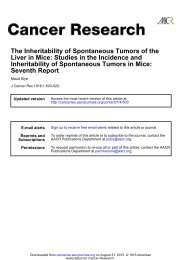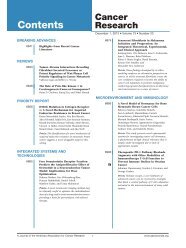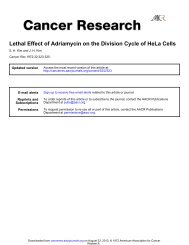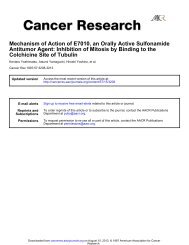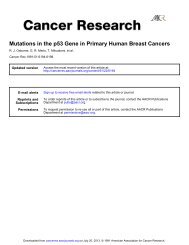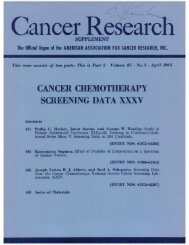XANTHOMA OF THE BREAST In a series of nine hundred (circa ...
XANTHOMA OF THE BREAST In a series of nine hundred (circa ...
XANTHOMA OF THE BREAST In a series of nine hundred (circa ...
You also want an ePaper? Increase the reach of your titles
YUMPU automatically turns print PDFs into web optimized ePapers that Google loves.
Downloaded from cancerres.aacrjournals.org on December 28, 2013. © 1932<br />
American Association for Cancer Research.<br />
<strong>XANTHOMA</strong> <strong>OF</strong> <strong>THE</strong> <strong>BREAST</strong> 1083<br />
and necrosis <strong>of</strong> cells. Whether secondary xanthomatous degeneration<br />
in neoplasms is correlated with hypercholesterinemia has<br />
not been determined. Blood cholesterin determinations have<br />
been done in only a few <strong>of</strong> these cases. <strong>In</strong> the two cases <strong>of</strong> xanthomatous<br />
carcinoma reported by Dubs there was no hypercholesterinemia.<br />
Because <strong>of</strong> their comparative frequency, and because their<br />
questionable nature has led to a confusing terminology, the<br />
giant-cell tumors showing xanthomatous degeneration which occur<br />
in the aponeuroses, tendon sheaths, and joint capsules <strong>of</strong> the extremities<br />
deserve to be considered as a separate group. These<br />
tumors have been designated by a great variety <strong>of</strong> names, including<br />
giant-cell sarcoma, xanthoma, xanthosarcoma, myeloxanthoma,<br />
myeloma, fibroma, granuloma, and endothelioma.<br />
They are the most frequently seen <strong>of</strong> all the varieties <strong>of</strong> tumor<br />
which contain foam cells. Growing slowly over a period <strong>of</strong> years,<br />
and perfectly benign, they form a distinct type <strong>of</strong> tumor. They<br />
are characterized in the gross by their encapsulation and, depending<br />
upon the extent to which xanthomatous degeneration has gone,<br />
by their yellow or brown color. Histologically they consist <strong>of</strong><br />
spindle or polyhedral cells which some authors regard as endothelial,<br />
giant cells <strong>of</strong> the foreign body type, foam cells, lymphocytes,<br />
and a connective tissue stroma, which may be very dense.<br />
Cholesterin crystals and hemosiderin pigment may be prominent.<br />
The structure varies a great deal. Some tumors are cellular and<br />
made up entirely <strong>of</strong> the spindle or polyhedral cells. <strong>In</strong> others the<br />
giant cells predominate. <strong>In</strong> many the xanthomatous degeneration<br />
has progressed to such a degree that the tumor is almost wholly<br />
made up <strong>of</strong> foam cells. Unfortunately these giant-cell tumors<br />
showing xanthomatous degeneration have come to be regarded<br />
as a separate group and are <strong>of</strong>ten improperly designated as xanthomas<br />
or xanthosarcomas. <strong>In</strong> reality they are but a variation <strong>of</strong> the<br />
banal giant-cell tendon sheath tumor.<br />
Weil, Landois and Reid, Broders, and Garrett have reported<br />
<strong>series</strong> <strong>of</strong> cases <strong>of</strong> these xanthomatous giant-cell tumors. Kirch<br />
was the first to appreciate, however, that they are not true xanthomas<br />
but simply neoplasms in which secondary xanthomatous<br />
degeneration has occurred. <strong>In</strong> his opinion any type <strong>of</strong> cell may<br />
be transformed into a foam cell by the deposition <strong>of</strong> cholesterin.<br />
Kirch made blood cholesterin determinations in seven patients<br />
with tumors <strong>of</strong> this type and found an elevated cholesterin in



